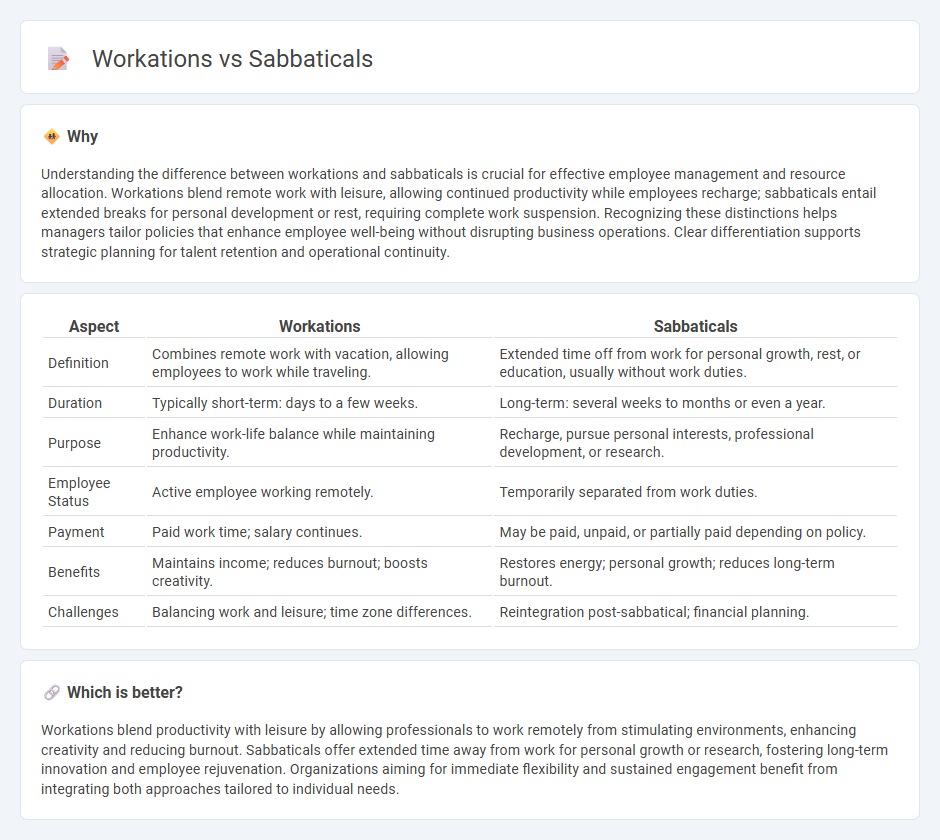
Workations combine remote work with travel, boosting productivity and reducing burnout by offering a change of scenery without interrupting professional responsibilities. Sabbaticals provide extended time off for personal growth, research, or skill development, fostering long-term career advancement and mental well-being. Explore the benefits and challenges of workations and sabbaticals to determine the best strategy for your management approach.
Why it is important
Understanding the difference between workations and sabbaticals is crucial for effective employee management and resource allocation. Workations blend remote work with leisure, allowing continued productivity while employees recharge; sabbaticals entail extended breaks for personal development or rest, requiring complete work suspension. Recognizing these distinctions helps managers tailor policies that enhance employee well-being without disrupting business operations. Clear differentiation supports strategic planning for talent retention and operational continuity.
Comparison Table
| Aspect | Workations | Sabbaticals |
|---|---|---|
| Definition | Combines remote work with vacation, allowing employees to work while traveling. | Extended time off from work for personal growth, rest, or education, usually without work duties. |
| Duration | Typically short-term: days to a few weeks. | Long-term: several weeks to months or even a year. |
| Purpose | Enhance work-life balance while maintaining productivity. | Recharge, pursue personal interests, professional development, or research. |
| Employee Status | Active employee working remotely. | Temporarily separated from work duties. |
| Payment | Paid work time; salary continues. | May be paid, unpaid, or partially paid depending on policy. |
| Benefits | Maintains income; reduces burnout; boosts creativity. | Restores energy; personal growth; reduces long-term burnout. |
| Challenges | Balancing work and leisure; time zone differences. | Reintegration post-sabbatical; financial planning. |
Which is better?
Workations blend productivity with leisure by allowing professionals to work remotely from stimulating environments, enhancing creativity and reducing burnout. Sabbaticals offer extended time away from work for personal growth or research, fostering long-term innovation and employee rejuvenation. Organizations aiming for immediate flexibility and sustained engagement benefit from integrating both approaches tailored to individual needs.
Connection
Workations and sabbaticals both enhance employee well-being and productivity by promoting extended breaks from traditional work environments. Companies integrating workations and sabbaticals report increased creativity, reduced burnout, and higher retention rates. These approaches align with progressive management strategies emphasizing work-life balance and mental health.
Key Terms
Employee Well-being
Sabbaticals offer extended time off to pursue personal growth, reducing burnout by providing employees with deep rest and new experiences, while workations combine work and travel, promoting flexibility but potentially blurring work-life boundaries. Studies reveal sabbaticals improve mental health and job satisfaction more significantly, whereas workations support creativity and work engagement through change of environment. Explore how both options impact employee well-being and the best fit for your organization's culture.
Productivity
Sabbaticals offer extended breaks from work, allowing employees to recharge and pursue personal growth, which can lead to significant boosts in long-term productivity and creativity. Workations combine work and leisure by enabling professionals to work remotely from inspiring locations, fostering immediate productivity improvements through a refreshed environment and reduced burnout. Explore more about how these approaches impact productivity and which might suit your work style best.
Work-life Balance
Sabbaticals provide extended time off from work, allowing employees to recharge deeply, pursue personal projects, or travel, which can significantly enhance long-term work-life balance. Workations combine remote work with leisure travel, enabling professionals to maintain productivity while experiencing new environments, fostering a more flexible approach to balancing career and personal life. Explore how integrating sabbaticals and workations can transform your work-life harmony and boost overall well-being.
Source and External Links
Sabbatical - Wikipedia - A sabbatical is an extended break from work, originally based on the Biblical practice of resting the land every seven years, commonly offered in academia as paid leave to focus on research or rest while still employed.
What Is Sabbatical Leave? It's the Best Kept Secret in HR - BetterUp - A sabbatical is a period away from work where employees remain employed and sometimes paid, allowing time for rest, personal growth, or skill development, increasingly used beyond academia to boost retention.
What Is a Sabbatical Leave Policy: Definition & How It Works - Sabbatical leave is a longer than usual leave granted by employers for personal or professional growth, typically after years of service, which can be paid or unpaid and lasts from months up to a year.
 dowidth.com
dowidth.com